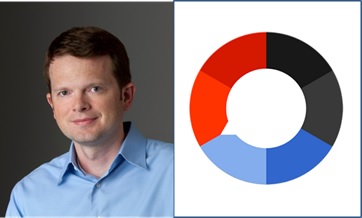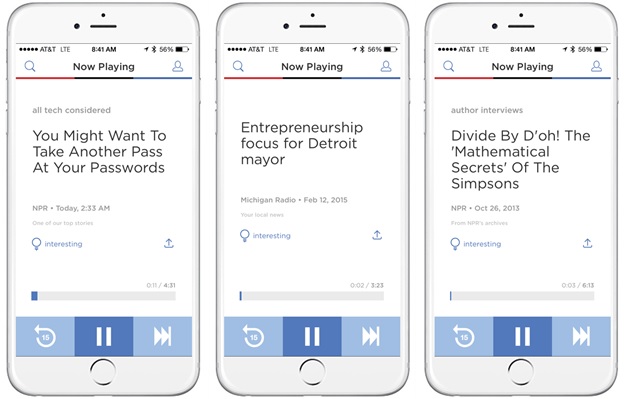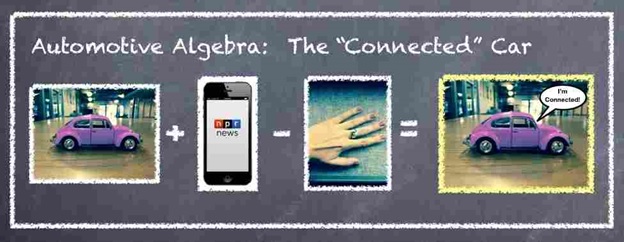When we launched our “Radio’s Most Innovative” initiative last August, we started making lists of possible candidates from the past and the present. On the latter list, NPR One was near the top from day one.
If you aren’t familiar with this remarkable app, you probably don’t work in public radio. NPR One is one of the most imaginative, bold, and talked about projects in NPR history. NPR One “soft launched” last summer as a digital listening app that blends content from both NPR programs and local public radio stations. It is a simple, elegant app that has the feel of a music pure-play experience, but from the public radio side of the street. For a broadcast radio network, in particular, it is quite the achievement.
Former NPR CEO Gary Knell described the project well before it launched as “a Pandora for news.” And recently in an interview with Current, NPR’s new CEO, Jarl Mohn, talked about how the ways the app is evolving:
“We will continue to get better at personalizing it, which was the whole idea behind NPR One. It’s going to become more finely tuned to individual listeners or users. To the extent that we can continually get better at that, the more successful we’ll be. There’s no question about mobile’s importance to our future.”

One of the interesting aspects of a mobile app initiative like NPR One is its ability to teach radio broadcasters about the behaviors that exist in the real-time listening process. To learn more about NPR One, the strategy, and the execution, we went to the source – Zach Brand (pictured at right). As NPR’s VP of Digital Media, he oversees NPR’s digital products, platforms and experiences, including NPR One.
JM: For those who haven’t yet enjoyed the NPR One app, tell us about it.
Zach: NPR One is the digital listening app that creates a personalized blend of local, national and international news and programming that could only be brought to you by public radio. No matter what time or day — NPR One always provides the latest news from NPR and your local NPR member station and puts you, the listener, in control. You can mark stories as interesting, pause, skip or share the news and entertaining stories that you might have otherwise missed.
JM: It’s been called “Pandora for news.” What’s the strategy – is it about mobile, podcasting, customization – or what?
Zach: We want to build the best digital listening experience for news and spoken word, period. Our audience expects to hear both the most important and also the unexpected. The role of editorial curation is so much more important with news than music. Unlike music, where we enjoy listening again and again to our favorite songs, nobody wants to hear the same news story twice. But we do want to put much more control in the hands of our listeners. This experience must layer machine learning and personalization on top of human expertise – not in lieu of it.
JM: NPR has had a successful mobile strategy for years. Why did you feel that you needed to add NPR One?
Zach: As much as we had done with mobile, consumer behavior keeps changing and we felt that there were opportunities around our core strength of audio that we had not yet realized. When we observed early trends in digital and mobile media consumption, we felt the time was right and that we were uniquely suited to create an amazing local / national continuous on-demand listening experience. An experience that is a brand new way of listening to public radio – responsive to the listener’s tastes and routines.
JM: Is NPR One additive to the consumption of your content; is it merely shifting audience away from the radio, or a combination of both?
Zach: Like I said before, we want to meet the audience wherever they are: terrestrial radio, online, streaming, podcasts or apps. The point is that their experience of public radio content –rigorous reporting, insights on life and moments of discovery– should be seamless no matter the platform. NPR One is designed for those who expect some or all of their listening to occur digitally. It is not cannibalizing traditional radio listening; it is bringing our content to a growing audience. A group that importantly, but not exclusively, includes younger audiences who frequently don’t even own a radio.
JM: Describe how you integrate local public radio stations into NPR One and how have public radio stations reacted to the app?
Zach: NPR One was built in collaboration with our station partners. From day one it was designed to bring the local / national experience of public radio to the audience. The content in NPR One includes local and national newscasts, local and national stories and other programming. Of all of this – local news programming is the content most likely to engage our audience.
Local stations determine what local content to include for the listeners in their community. This allows the experience to leverage both the best local and national editorial news judgment. Stations in turn gain a new avenue for generating visibility and support for their station. That listener support is fundamental to the public radio economy. We see NPR One as another place for audiences not only to engage but also support their local stations.
The reaction among stations is supportive. NPR One is designed to connect the audience with NPR, and we are both eager to see what lessons we can learn and how we can better serve our public service mission.
JM: NPR One launched with a beta test of XAPP ads. What are they and how did they work for you?
Zach: NPR was the first radio publisher to provide this voice-activated feature, allowing listeners to “talk back” to the app and have it play a specific story or hear a sample from a different program, or interact with sponsorships. Users often are listening in our apps in background mode, and cannot easily touch or look at their devices. The option of voice response improves the experience and gives them greater control, and we have seen excellent engagement with both content promotions and sponsorships. It’s just one example of the technological innovations we expect to introduce as we continue to iterate with NPR One.
JM: NPR One provides you with a lot of data on the types of stories your listeners like, and want to skip. What patterns have emerged and what has surprised you? What would surprise us?
Zach: Something that might be surprising for a radio experience is that apparently people will judge audio by its headline: 37% of skips occur in the first 3 seconds.
Another thing that might be surprising: there has been no decrease in use of the NPR News app or live streams. There is space for all the above. People use them for different things.
JM: You get to see “skip patterns” – much like Pandora and Spotify do. What have you learned from what consumers skip and what holds their interest?
Zach: We have so much interesting data right now. What we need to do is dig into it, analyze it, and understand what it means! Something we have noticed is that people prefer the shorter stories in the morning: they want to quickly hear all the news with short pieces that are to the point. But later in the afternoon they’re ready for longer, more in depth, contextual pieces and interviews. But these are general truths. Not everybody’s morning listening preference is the same; nor should they be! The more we get to know our users, the better we’ll be able to “predict” what they want when they want it. So whether they want to get caught up on the news on their way to work – or something to entertain them while walking the dog — we’ll offer the appropriate content to them at that time.
JM: How is NPR One used? Is it mostly during the day at work, during “down times” in the evening when people are relaxing, or in the car?
Zach: Listening patterns are similar to broadcast, though they are more spread throughout the day and into the evening. In fact – one of the most requested features people asked for was a sleep timer!
JM: What is NPR One’s automotive strategy?
Zach: Radio has a special relationship with driving, the intimacy of listening to someone’s voice in the small space of the car. NPR’s strategy is to ensure that public radio remains an integral part of the automotive listening environment no matter how the technology changes. This space continues to evolve, but we’ve established partnerships with nearly every major car manufacturer (and many others working in the automotive space) to guarantee that we can continue to deliver those driveway moments that keep our audience listening even after their commute is over.
JM: Is there a plan to market NPR One to the public radio audience?
Zach: Yes, when and how it makes sense. Our marketing at present is allowing organic growth through word of mouth and social sharing. This enables us to focus our resources on ongoing improvements. We are excited to see a continued influx of new users as we iterate and improve the NPR One experience. We approach marketing strategies much the same way as we approach product development – as we learn and see patterns of use and engagement, so we will test and implement the most effective marketing tactics.
JM: Public radio’s audience tends to be older. Do you expect NPR One to appeal to them, or is it a gateway to younger listeners?
Zach: That feels like a false choice. NPR One is not for a particular age group – but rather for those who want a digital experience. NPR existing listeners tend to be very tech savvy. I expect many of them will enjoy having NPR One as an additional option for listening. And of course an important opportunity to reach new audiences is in reaching younger audiences – including ‘digital natives’ born after 1980. We want to be where the listeners want us to be; to make our content available to them at their convenience and in their preferred platform.
JM: What’s next for the app & for this initiative? Where can you take it from here?
We are only getting started. The data we are currently getting from NPR One is offering us new insights and generating further questions every day. While we intend to keep the simple and intuitive interface, there will be new features and improvements coming soon. We will also be bringing NPR One to more platforms. Smartphones, connected cars, connected homes and whatever new devices our audience use. Finally, we are working to better include the full breadth of public radio in the listening experience.
JM: What’s the biggest barrier to innovation in your opinion?
Zach: The biggest barrier to innovation is the fear of making a mistake, which is appalling because innovation invariably involves various “mistakes” along the way. Two questions we’ve focused on during this initiative are 1) are we serving our audience needs? and 2) are we learning? The reason for the first is hopefully obvious. The intent of the second is to avoid paralytic fear by keeping us moving quickly, being disciplined, and able to learn from both our mistakes and victories.
(Full disclosure, our apps company has a partnership with XAPP Media and Jacobs Media has provided research and consulting services to NPR.)
INNOVATION QUOTE OF THE WEEK
“Life is trying things to see if they work.”
Ray Bradbury
More of Radio’s Most Innovative
- Radio's Most Innovative: Innovate This
- Radio’s Most Innovative: Horizon Media & “Moodstates”
- Radio’s Most Innovative: Shazam For Radio
- Radio’s Most Innovative: Nikki Marra’s “College Radio Road Trip”
- Radio’s Most Innovative: “Radio’s Best Friend” Art Vuolo
- What To Do If Your Radio Station Goes Through A Midlife Crisis - April 25, 2025
- A 2020 Lesson?It Could All Be Gone In A Flash - April 24, 2025
- How AI Can Give Radio Personalities More…PERSONALITY - April 23, 2025








Leave a Reply